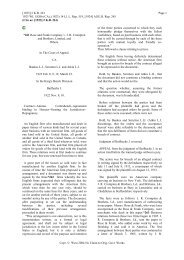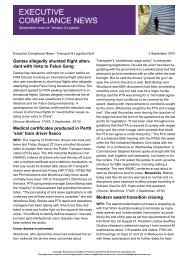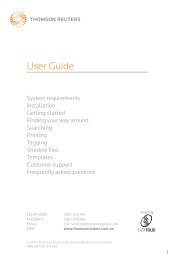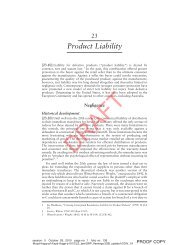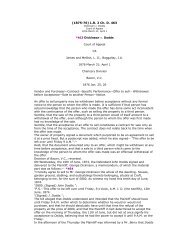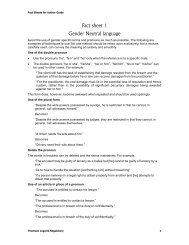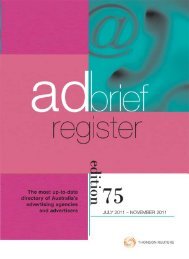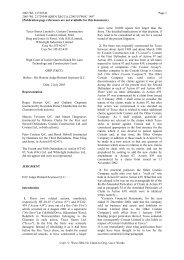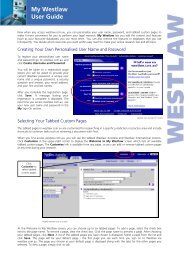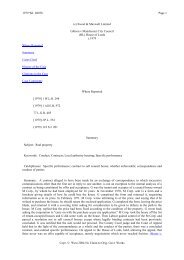Holmes v Jones - Thomson Reuters
Holmes v Jones - Thomson Reuters
Holmes v Jones - Thomson Reuters
- No tags were found...
You also want an ePaper? Increase the reach of your titles
YUMPU automatically turns print PDFs into web optimized ePapers that Google loves.
4 CLR 1692 Page 81907 WL 12437 (HCA), 14 ALR 89, 7 SR (NSW) 821(Cite as: 4 CLR 1692)made to induce that other to purchase the articleoffered. But unless it may reasonably be inferredfrom the vendor's conduct or words that therepresentation was made for that purpose, the lawdoes not cast upon him the responsibility for therepresentation. His words and acts must be lookedat and regarded as an ordinary reasonable businessman would look at them. The question for ourdetermination is whether, considering all thecircumstances which occurred, particularly thenegotiations which took place between the proposalof Trebeck on 20th November and the actualacceptance of the offer on 19th December, theinference can be reasonably drawn that the contractwas induced by the misrepresentation. It is notnecessary for me to follow my learned brother theChief Justice in his statement of the facts. I entirelyagree with him in the view he has expressed. Iwould only observe that it appears to meimpossible to say that the representations of 20thNovember materially induced the contract finallymade when we consider the change in the form ofdealing between the proposal of 20th Novemberand the contract afterwards entered into, theinspection by Campbell, which, though it tookplace before the actual proposal and was not adirect inspection for the purpose of looking at thestock, was one which *1708 procured informationabout the stock, and when we remember thatCampbell's inspection was followed by aninspection of the stock made by Easy for theexpress purpose of informing the appellants. In myopinion, therefore, no jury could reasonably cometo the conclusion that the misrepresentation inTrebeck's letter of 20th November was aninducement to the making of the contract of 3rdJanuary. That being so, the plaintiffs failed on thatpoint, and on that ground alone the defendants areentitled to have a verdict entered for them.There is another question on which it seems to meclear that it is impossible for the plaintiffs to holdtheir verdict. It is just as material a portion of theircase to prove damages resulting from the makingof the contract as to prove the misrepresentationitself. But there is no evidence for the jury of anydamage arising out of the making of the contract. Itseems to have been assumed at the trial that thekind of evidence necessary to prove damage for abreach of warranty is sufficient in a case of thiskind. That is not so. The cases which have beencited from Sedgwick's Ruling Cases no doubtappear to show that in some States of America thelaw is as was contended for by the respondents. Butit does not appear that even in America that is thegeneral law, because I gather from the statementquoted from Marshall v. Hubbard(1) that the law inAmerica is just as it is in England, that there mustfollow upon the making of the contract induced byfraudulent misrepresentation some resultingdamage which must be proved before the plaintiffcan succeed. It was said in that case by the Judge insumming up to the jury, and the statement wasafterwards approved by the Supreme Court of theUnited States (2):-"But there are certain otherelements of fact which necessarily enter into thisdefence. Not only must the representations bemade, not only must they be fraudulent, and notonly must it appear that the party relied, and had aright to rely, upon them, but it must also be shownthat the representations were material to thecontract or transactions which took place betweenthe parties; and, further, that injury has beensustained, damage has resulted to the defendantfrom the alleged fraudulent representations." Thatstates the *1709 law in exactly the same way as itis laid down in the cases cited by my learnedbrother the Chief Justice. I need not repeat thequotations, and as to them I only wish to say that Ientirely concur in the statement of the law as laiddown in Broome v. Speak(1). Applying that law tothe facts of the case, the only question is, has therebeen any evidence of this damage? Undoubtedlythere is some evidence of damage for a breach ofwarranty. But the damage to be proved here doesnot rest on the same principle. Damages for abreach of warranty are given on the principle that,where a person contracts to do something and failsto do it, he must put the other party in the sameposition as if the thing had been done, so far asmoney can do it. But where the complaint is thatthe contract has been induced by a fraudulentmisrepresentation, the remedy for that wrong is toput the party, who has been induced to make thecontract, as far as possible in the position he wouldhave been in if he had not entered into the contract.To put him into that position he must berecompensed for the damage he has sustained byentering into the contract. In order to ascertain theextent of that damage the whole contract must belooked at. If it should turn out that though in onerespect the contract is less beneficial to the otherparty than it would have been if the representationhad been true, yet in other respects it is soprofitable that on the whole he loses nothing, nodamage has resulted from his entering into thecontract and he cannot recover. Thus damage is anessential factor in the cause of action.Under these circumstances it appears to me that theprinciple must be applied that material damage is anecessary element in the action, and damage hasnot been proved. On that ground also the verdictshould be entered for the defendants.Copr. © West 2004 No Claim to Orig. Govt. Works



